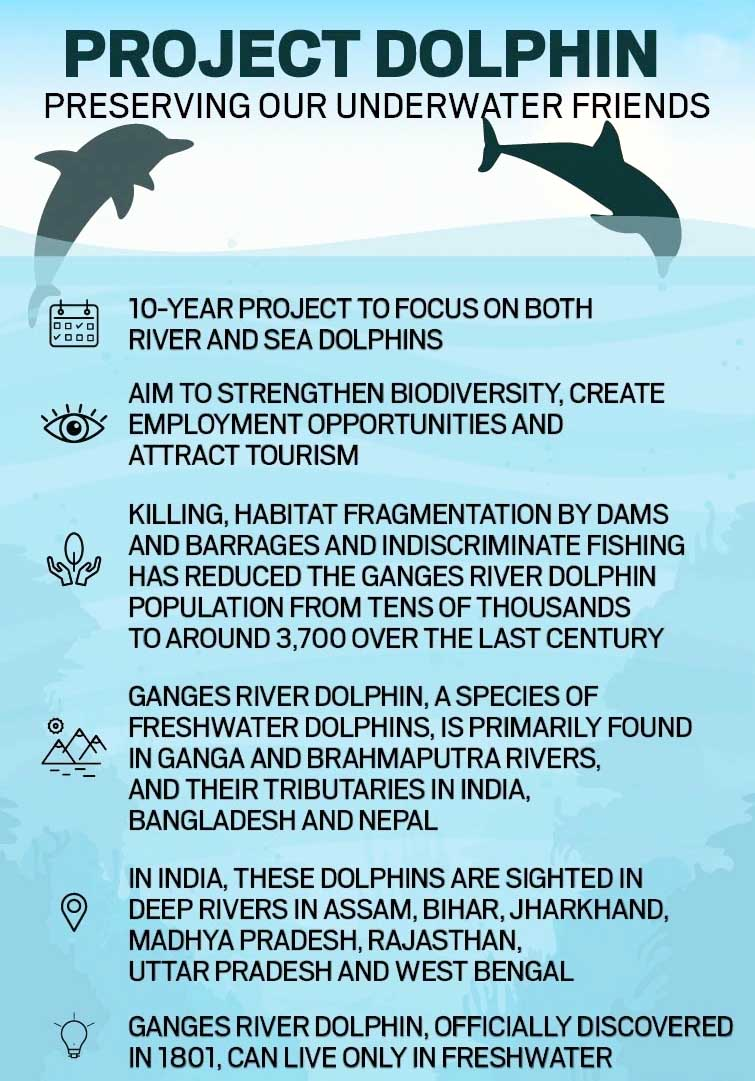Biodiversity & Environment
Project Dolphin
- 16 Mar 2022
- 6 min read
For Prelims: National Mission for Clean Ganga, Gangetic Dolphin, steps taken by the government to conserve dolphins.
For Mains: Conservation, Government Policies & Interventions, Project Dolphin and its Significance.
Why in News
Recently, the MInistry of Jal Shakti expressed his displeasure over the slow pace of the approval process for Project Dolphin.
What is Project Dolphin?
- The initiative got in-principle approval in 2019 at the first meeting of the National Ganga Council (NGC), headed by the Prime Minister.
- Project Dolphin is one of the activities planned under Arth Ganga, an ambitious inter-ministerial initiative of the government approved in 2019.
- Project Dolphin will be on the lines of Project Tiger, which has helped increase the tiger population.
- It is expected to be implemented by the Ministry of Environment, Forest and Climate Change.
- A Special Conservation program needs to be taken up for Gangetic Dolphin which is a national aquatic animal and also indicator species for the river Ganga spread over several states.
- Indicator species, organisms—often a microorganism or a plant—that serves as a measure of the environmental conditions that exist in a given locale.
- As the Gangetic dolphin is at the top of the food chain, protecting the species and its habitat will ensure conservation of aquatic lives of the river.
- So far, the National Mission for Clean Ganga (NMCG), which implements the government’s flagship scheme Namami Gange, has been taking some initiatives for saving dolphins.
- A Special Conservation program needs to be taken up for Gangetic Dolphin which is a national aquatic animal and also indicator species for the river Ganga spread over several states.
- Global Experience: The Rhine Action Plan (1987) of the International Commission for the Protection of the Rhine (ICPR) — representing Switzerland, France, Germany, Luxemburg and the Netherlands — helped in conservation of the salmon fish (also an indicator species).
PYQ
Which one of the following is the national aquatic animal of India? (2015)
(a) Saltwater crocodile
(b) Olive ridley turtle
(c) Gangetic dolphin
(d) Gharial
Ans: (c)
What are the Key Points Related to Gangetic Dolphin?
- Scientific Name: Platanista gangetica gangetica.
- Discovery: It was officially discovered in 1801.
- Habitat: They live in the Ganges-Brahmaputra-Meghna and Karnaphuli-Sangu river systems of Nepal, India, and Bangladesh.
- The Ganges river dolphin can only live in freshwater and is essentially blind.
- They hunt by emitting ultrasonic sounds, which bounces off of fish and other prey, enabling them to “see” an image in their mind. They are also called ‘susu’.
- Population: The global population of the species is estimated at 4,000, and nearly 80% found in the Indian subcontinent.
- Significance:
- It is a reliable indicator of the health of the entire river ecosystem.
- Threats:
- Bycatch: These dolphins and people both favour areas of the river where fish are plentiful and the water current is slower.
- This has led to fewer fish for people and more dolphins dying as a result of accidentally being caught in fishing nets, also known as bycatch.
- Pollution: Industrial, agricultural, and human pollution is another serious cause of habitat degradation.
- Dams: Construction of dams and other irrigation-related projects make them susceptible to inbreeding and more vulnerable to other threats because they cannot move to new areas.
- Dolphins below a dam are threatened by heavy pollution, increased fishing activities and vessel traffic. They also have less food because dams disturb the migration, breeding cycles and habitat of fish and other prey.
- Bycatch: These dolphins and people both favour areas of the river where fish are plentiful and the water current is slower.
- Conservation Status:
- Indian Wildlife (Protection), Act 1972: Schedule I.
- International Union for the Conservation of Nature (IUCN): Endangered.
- Convention on International Trade in Endangered Species (CITES): Appendix I (most endangered).
- Convention on Migratory Species (CMS): Appendix II (migratory species that need conservation and management or would significantly benefit from international co-operation).
- Other Steps Taken:
- National Dolphin Research Centre (NDRC): The NDRC is coming up on the 4,400 square metre plot of land on the premises of Patna University for the conservation of the endangered Gangetic river dolphin.
- Dolphin Sanctuary: Vikramshila Ganges Dolphin Sanctuary has been established in Bihar.
- National Ganga River Dolphin Day: The National Mission for Clean Ganga celebrates 5th October as National Ganga River Dolphin Day.
- Conservation Plan: The Conservation Action Plan for the Ganges River Dolphin 2010-2020, which “identified threats to Gangetic Dolphins and impact of river traffic, irrigation canals and depletion of prey-base on Dolphins populations”.
PYQ
Other than poaching, what are the possible reasons for the decline in the population of Ganges River Dolphins? (2014)
1. Construction of dams and barrages on rivers
2. Increase in the population of crocodiles in rivers
3. Getting trapped in fishing nets accidentally
4. Use of synthetic fertilisers and other agricultural chemicals in crop-fields in the vicinity of rivers
Select the correct answer using the code given below:
(a) 1 and 2 only
(b) 2 and 3 only
(c) 1, 3 and 4 only
(d) 1, 2, 3 and 4
Ans: (c)







